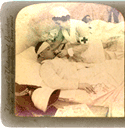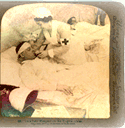> EDITORIAL
  |
| Cover image: Stereograph of a nurse tending a wounded soldier during the Boer War. The image on the right is taken from a slightly different angle from that on the left. When viewed through a stereoscope, one of the earliest forms of image manipulation technology, the two images appear as one 3D image.
(From the Editor’s private collection) |
This issue of Transformations explores the experience of regionality in Australia with a specifically Queensland focus. All of the papers were originally presented at a conference held by the Australia Pacific Research Group, at the Bundaberg campus of Central Queensland University in October 1999. They represent a diverse set of responses to the question: what is regionality, and how is it experienced within a globalised context?
One of the most pressing issues facing regional areas today is the struggle to find new ways of identifying resources and meanings which will have a positive, empowering effect within the globalised contexts of postindustrial capital. This means turning away from earlier forms of self-identification, which sought to locate a regional essence within in its own territorial domain, and instead, seeking to redefine the region in terms of broader global terrains characterised by unstable flows of communication and volatile capital resources.
In order to do this, we need ways of rethinking the ‘givens’ of regionality: the values, identities and practices which have traditionally served as the mark of uniqueness of any region, to submit them to critical scrutiny so that we aren’t lulled into thinking they exist as a natural or inevitable characteristic of the region.
The papers in this issue of Transformations all, in their own way, submit these traditional values of regional identification to critical scrutiny, exposing the constructedness of some of the practices within institutions, as well as the instability of the mediated forms of cultural expression and communication. They also suggest productive ways in which regionality can be turned to advantage, by working from the margins, and bypassing the centre.
One of the most important ways in which the future of a region can be changed is by a thorough understanding of the historical context in which that future is made possible. Historical studies can play an important part in mapping new regional identities. This is especially the case with regional culture. By uncovering the way communities in regional areas gain a sense of identity and form common allegiances through everyday practices such going to the movies, watching television, attending dances, being involved in popular arts, and sports, as well as media representation, cultural historians are able to access some of the basic values and orientations of regional life.
For instance, Denis Cryle, Betty Cosgrove and Ray Boyle’s article ‘Birch, Carroll and Coyle and the Regional Picture Palace: a case study’ provides a fascinating commentary on the vibrant cinema culture of the central Queensland city of Rockhampton in the first half of the twentieth century. It shows the prominent place that cinemas had in regional Australia, and indeed, indicates the progressive nature of the cinema industry in Rockhampton, which, in many respects, took a leading role in the establishment of cinema outside of the metropolitan centres of Australia.
My own examination of some early film shot by pioneer film makers, Wills and Mobsby at the turn of the twentieth century for the Queensland government, shows how Queensland, as a colonial province, was ‘imagined’ and how this imaginary was based on an ambiguous relation between the metropolitan centre of Brisbane and the farming regions of the colony. The article, entitled ‘Imagining Colonial Space in Regional Queensland: film and governance’, shows how these films projected a visual image of Queensland in aesthetic terms, with a specifically regional character, which can still be detected today.
Wendy Madsen looks at practices of nursing at the Rockhampton hospital in the middle of the twentieth century. Her article, ‘Learning to be a nurse: the culture of training in a regional Queensland Hospital, 1930–1950’ shows how nurses in regional hospitals were subject to a strict disciplinary regime, indicating a style of health governance with its origins in nineteenth century British institutions.
Jacqui Ewart’s article, entitled ‘Capturing the Heart of the Region—how regional media define a community’ analyses media reports of an abduction and murder which took place in Rockhampton in 1999. Jacqui shows how the media stories worked to construct a certain concept of the community by using pre-determined ideas and values which were fed into the reports. The article indicates just how powerful the media is in smaller regional areas, and shows how attitude change in a more general sense may be difficult when confronted with such practices.
Jim Douglas’s paper ‘Identity Through Sound and Image: This is Australia?’ shows how popular music composed and developed in regional Australia has made its mark in both national and global contexts. Through a detailed analysis of the music of two regionally based groups, GANGgajang and Seventh, Jim shows how local cultural production can flourish by appropriating global resources for its own ends. Jim argues that it may be possible as a consequence of the new technologies of the internet, to re-establish regional identities in the face of global homogenisation in the field of popular music.
Popular music is also the topic of Karl Neuenfeldt’s paper. Entitled ‘The Transformative Effects of CDs on the Australian Folk Festival Scene’, the paper looks at the regional folk festival scene in Australia, and the way folk singers use CD technology to publicise their acts. Karl shows how CDs have become an integral feature of the folk music scene, enabling obscure groups to gain wider publicity beyond the folk festival scene, as well as providing a way of selling their act to the folk festival organisers. Karl’s paper indicates how modern technology has led to a blending of live and recorded music, where it is now impossible to conclude that one is the origin of the other.
Each of these papers deals with the struggle of people working in regional Australia to make themselves heard within wider national and international contexts, or to appropriate the modern technologies of communication, institutional and mediated culture to improve and modernise everyday life. They show how regional Australia has responded to the challenge of breaking through colonial restrictions, and in many instances, enabling progressive, ideas and influences to come to the fore. A reading of these articles will provide much material for further work in regional culture, as it grapples with the task of redefinition in today’s globalising world.
Warwick Mules
Issue Editor
September 2000
Denis Cryle, Betty Cosgrove and Ray Boyle
Birch, Carroll and Coyle and the Regional Picture Palace: a case study
> Abstract
The article outlines the regional origins of Birch, Carroll and Coyle in Queensland with special reference to Rockhampton and the Wintergarden theatre. The emergence of a distinctive regional theatre designed to attract new audiences for Hollywood product, along with live entertainment capacity, were major factors in sustaining the dominance of BCC in regional Queensland for almost half a century.
Jim Douglas
Identity Through Sound and Image: This is Australia?
> Abstract
Beginning with the example of GANGgajang’s song The Sounds of Then, this discussion explores whether or not there is such a thing as an Australian sound in popular or rock music. Of particular concern are the actions of transnational corporations, the Internet and governments in the creation or subversion of such a notion. Sometimes national or transnational groups appropriate regional or local identities in order to ‘infiltrate’a society. Such groups are often concerned with misappropriation of ‘the local’ in order to acquire a particular hegemonic position. Rather than resisting the forces of global capital, so-called ‘local’ sites may indigenise aspects of Imperialist cultures. However, ignoring the reality of contemporary global organisations is folly. Not only that, but ‘local’cultural forms will always survive so long as there are those that wish to have a ‘voice’of their own. And, in the case of rock music, is the national point of origin really all that much of an issue?
Jacqui Ewart
Capturing the Heart of the Region – how regional media define a community
> Abstract
This paper examines the role regional media play in constructiing a region’s publics. It examines how journalists at one regional newspaper conceptualise the public and investigates how these concepts are played out through a series of articles from the same newspaper.
Wendy Madsen
Learning to be a nurse: the culture of training in a regional Queensland Hospital, 1930 – 1950
> Abstract
Young women wishing to train as a nurse during the early part of this century, entered into a hospital environment which taught them not only the skills of nursing, but also skilled them in how to be a nurse. Along with learning how to do a dressing, they learnt obedience,and while learning how to clean the pan room, they learnt about hierarchy and the traditions of nursing. Trainees were required to live and work within the confines of the hospital grounds,and as such, developed a distinct culture that was a compilation of work, moral and traditional elements.
This paper will use a combination of oral and documentary sources to examine the development of the nursing culture and the transformation of nursing students within the ward environment of the Rockhampton Hospital between 1930 and 1950. Focusing on a small regional hospital allows one to gain a greater understanding of the nursing culture, and to investigate this culture to a greater depth as it existed in one location. In particular,aspects of reinforcing the nursing culture will be examined, that is the communication channels that had to be followed, delegation of duties and the nursing hierarchy, and the socialisation of trainees by other trainees as part of the informal educational processes.
Warwick Mules
Imagining Colonial Space in Regional Queensland: film and governance
> Abstract
A series of films commissioned by the Queensland government in 1898 were made, showing a variety of scenes of metropolitan Brisbane and rural regions of Queensland. This paper examines some of these films in terms of the way they constitute a ‘colonial imaginary ’ involving the positioning of the spectator in time and space. By drawing on Metz’s ideas of the cinema apparatus, as well as Foucault’s arguments concerning the surveillance of space, the paper shows how these films can be read in terms of an imagined audience based on immigration policies at the time. Overall, the paper argues that films from previous eras should not be read simply as objective representations of a social context, but in terms of an imaginary constitution which is virtually located within the real, and involving a range of rhetorical and aesthetic practices and modes of presentation.
Karl Neuenfeldt
The Transformative Effects of CDs on the Australian Folk Festival Scene
> Abstract
This article explores the transformative effects of the compact disk (CD) on the Australian folk festival scene using the 1998 Australian National Folk Festival as a case study. Edited interviews and analysis highlight how CDs circulate along with musicians and music genres in a global cultural economy and musical technoculture. The CD is characterised as a marketing and musical product; a kind of cultural and symbolic capital; and, a pivotal part of the musicality, sociality,and commerciality of the folk festival scene, while it simultaneously helps transform musical and performative genres.
